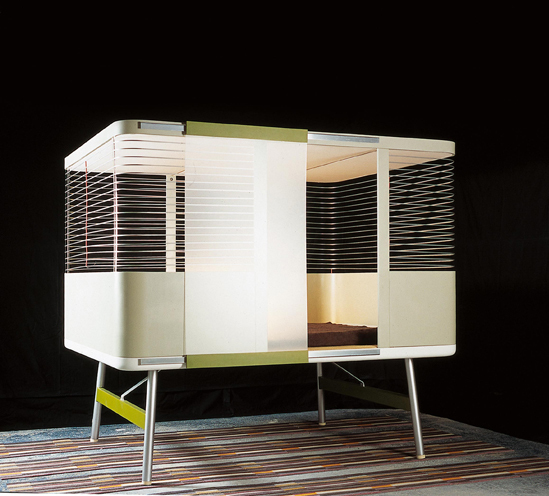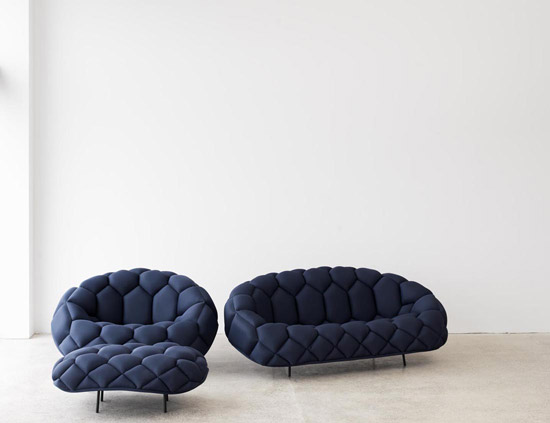Je ne regrette rien (most of the time, that is): Ronan Bouroullec in conversation with Architonic
Scritto da Simon Keane-Cowell
Zürich, Svizzera
04.02.11
'Regrets, I've had a few,' sang Sinatra in his classic ballad 'My Way', while Piaf famously insisted that she regretted absolutely nothing. Somewhere between these two lies Ronan Bouroullec, one half of the distinguished French go-to design duo, the Bouroullec Brothers. 'We've done a lot of disasters. But we've had the chance to do best-sellers, too. It's a mix, really,' he tells Architonic at the recent Cologne Furniture Fair.
The name Simon Cowell might make me a hostage to fortune, but, thankfully, that's the closest I get to celebrity status. Not so Ronan Bouroullec, one half of the renowned fraternal design partnership the Bouroullec Brothers – also often referred to as Ronan and Erwan Bouroullec or, quite simply, The Bouroullecs. Capital T, capital B. (I'll let you choose your preferred naming.) While waiting at Ligne Roset's stand at the recent Cologne Furniture Fair to interview Ronan, the elder of the two, I was fascinated to see how some visitors, particularly the younger, starry-eyed ones, were very keen to shake the man by the hand or have their photograph taken with him. But I guess that's what happens when you've had a career as prolific as this pair have.
The classic Chesterfield meets a ripe piece of fruit: Ronan and Erwan's seriously comfortable new stretch-fabric 'Ploum' sofa for leading French manufacturer Ligne Roset

The classic Chesterfield meets a ripe piece of fruit: Ronan and Erwan's seriously comfortable new stretch-fabric 'Ploum' sofa for leading French manufacturer Ligne Roset
×Growing up in the country in a household where design didn't really feature, as Ronan explains, the brothers left the rural Breton landscape behind them, moving to Paris, where they went on to change the landscape of contemporary design. In the course of their 15-year career, they have upped the creative ante in furniture and product design through their collaborations with some of the biggest guns in design manufacturing – among them Cappellini, Kartell, Ligne Roset, Magis and Vitra – their surname becoming shorthand for concept-strong work that marries the functional with the lyrical. Utilitarian romanticism, if you will.
'We've done a lot of disasters. But we've had the chance to do best-sellers, too. It's a mix, really': Ronan Bouroullec (right), pictured with brother Erwan, on the successes and frustrations of a prolific 15-year creative career
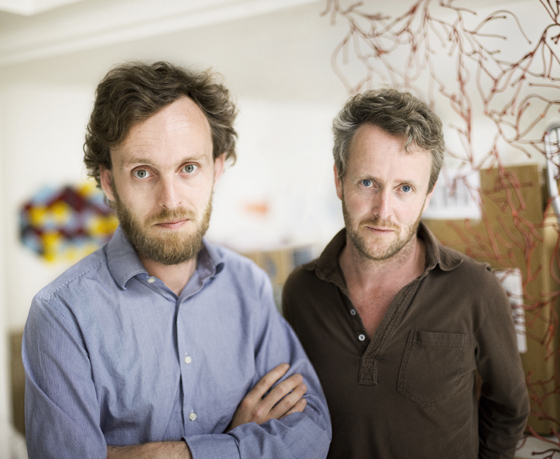
'We've done a lot of disasters. But we've had the chance to do best-sellers, too. It's a mix, really': Ronan Bouroullec (right), pictured with brother Erwan, on the successes and frustrations of a prolific 15-year creative career
×But it's not all rosy. An extremely likeable and engaged interviewee, Ronan Bouroullec confesses that he 'felt more comfortable ten years ago'. Creative recognition brings with it the pressure of expectation, while design practice, in industrial terms at least, is becoming increasingly regulated, threatening to stymie creative expression. But he's not complaining. With manufacturers still queueing up to work with the French design duo, Ronan recognises how professionally fortunate they are: 'We really are in a lucky situation,' he says. Two exhibitions of their work this year – one at the new Shigeru Ban-designed Centre Pompidou-Metz – testify to the continued interest in, and relevance of, their output.
Here, I talk to Ronan about his new 'Ploum' sofa for Ligne Roset (and why it's certainly not a Chesterfield), about the highs and lows (or 'disasters', as he puts it) of his career, and how he spends 99% of his time fighting with his brother.
Diamonds are forever: Erwan and Ronan Bouroullec's new 'Losanges' rug collection for Spanish brand Nanimarquina, hand-made in Pakistan and launched at this January's Maison & Objet in Paris
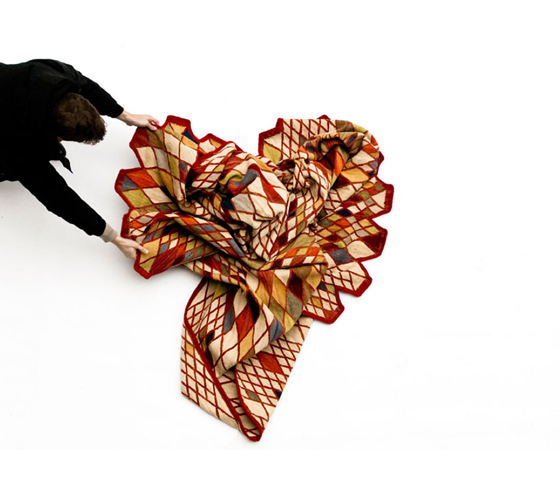
Diamonds are forever: Erwan and Ronan Bouroullec's new 'Losanges' rug collection for Spanish brand Nanimarquina, hand-made in Pakistan and launched at this January's Maison & Objet in Paris
×….
This new sofa for Ligne Roset is dangerously comfortable.
Yes, it's terrible.
Why did you design it? Why does it exist?
Well, you know this discipline of furniture design is something we've been working in for 15 years. The sofa is one of the important questions of the domestic landscape. I think we've done three or four in those 15 years. We turn around this question almost every day.
With this sofa, we started to do a test around the idea of it being almost like a fruit. Almost too juicy or ripe. One day more and it will have gone bad. It has a certain sensual quality.
To design a good sofa is complex. In the end, it's not very complicated to do a two- or three-metre-long sofa with a certain elegance. But do do something which is small with a good level of comfort and at the correct price, something that can go in urban flats, this becomes another type of question. It's exactly like cooking. A good project is something that is a balance between a lot of factors, a lot of small details and questions. So I think this sofa is not so bad. I especially like the quality of comfort. I think it's the best one that we've done in terms of comfort.
Erwan Bouroullec's punningly titled 'Lit Clos' sleeping platform from 2000
And the sofa seems to communicate visually, before you've had any kind of contact with it, that very idea of comfort.
That's true.
It's quite literal in that sense.
But sometimes it's a big deception. (Laughs.)
Or in this case not.
Two years ago, we did a very interesting sofa, too, for Established & Sons, called 'Quilt'. I was very happy with it because it was certainly quite new. The only problem was the quality of comfort. It has the idea of the 'muscle' about it, so it has two layers of stretched fabric sewn together, with cells. And in each cell is a piece of foam. So it was new in terms of the way it looked. Very expensive. Certainly why it was new was because nobody had done this before because it is so expensive.
But the balance between what you visually see and what you consider as comfortable is a bit disappointing when you test it. It's the same with a Chesterfield. This ('Ploum' sofa) technically comes from the Chesterfield idea. But here we've got just one piece of fabric.
The space-defining, flexible 'Joyn' office system by Ronan and Erwan Bouroullec for Vitra, 2002; © Vitra
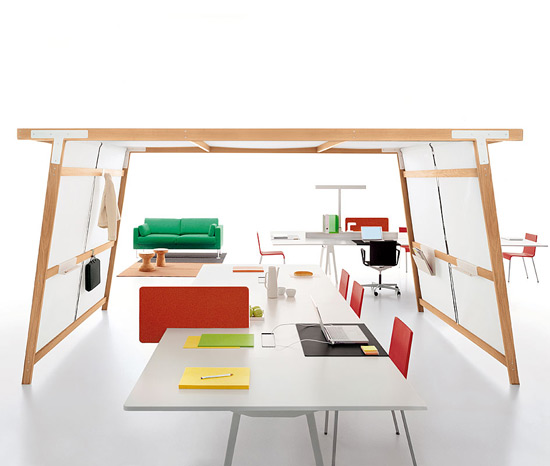
The space-defining, flexible 'Joyn' office system by Ronan and Erwan Bouroullec for Vitra, 2002; © Vitra
×And these nodes, these regular points cross the surface of the sofa, are pulled from behind.
Exactly. So it creates this Chesterfield effect. The only problem with a Chesterfield is that it's very hard. I only sat for the first time on a Chesterfield five years ago. For me, it had always been this marvellous idea of comfort. But I never imagined in reality that it would be like that. It's not a stretched fabric, so, if you introduce tension, it creates this marvellous plumping effect, but it's like stone.
Now you see me, now you don't: the Bouroullec Brothers' 'Alcove' work station for Vitra; photo Marc Eggimann, © Vitra
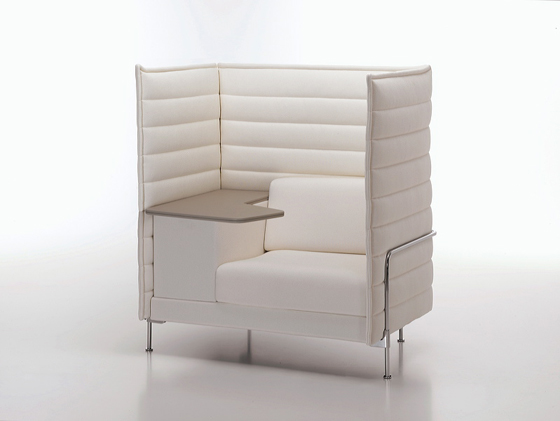
Now you see me, now you don't: the Bouroullec Brothers' 'Alcove' work station for Vitra; photo Marc Eggimann, © Vitra
×Did the process of working on this particular sofa teach you anything new?
Well, we face the fact that it's over 15 years that we've tried to design objects. We're not virgins anymore. So I didn't learn anything incredibly new. The sofa took a long time to develop. Especially finding the exact density, the quantity of foam. One month ago, we almost decided to stop working on it. It was really a fat, ugly animal. So, the process was long and tough.
The Bouroullecs' 'Quilt' sofa and chair for leading British design brand Established & Sons, 2009
And has the process of creating and designing for both of you in the course of your career become easier or more predictable do you think, given that you perhaps didn't learn anything radically new on this project? Is that fair to say?
Actually, it's more and more difficult for us. We really arrived from another world in a certain sense because we grew up in the countryside. Our parents never knew what design meant. I was very bad at school and at 15 I went to an applied-arts school. And after that I went to Paris, which for me was a big disappointment. I went to a design school, but the way that design was taught was a total nightmare. I felt that it wasn't at all my discipline. But, at 18, I started to draw for myself. I went to school and was a very bad design student, but at the end I got my diploma. But I had to try to find a way to accept this situation.
Our first client was Cappellini, which at the time was the most interesting company. To be part of that team was to be part of a very good football team, like Milan or Real Madrid. Since this time, we never had to propose our work to clients. Different companies – Vitra, Kartell, Magis – all of them came to us. So we really are in a lucky situation.
French design, Italian craftsmanship, British manufacturing: the 'Lighthouse' lamp, Ronan and Erwan Bouroullec's collaboration with Italian glass experts Venini for Established & Sons, 2010
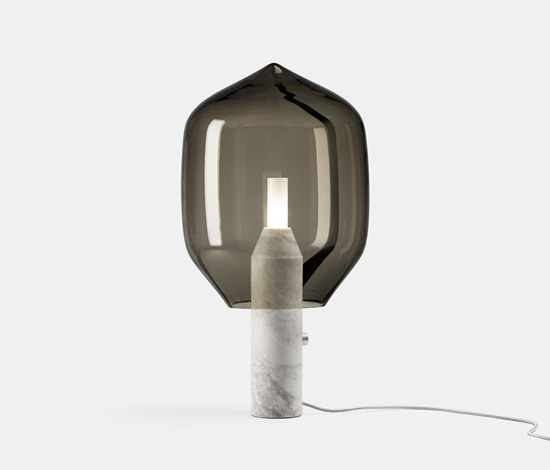
French design, Italian craftsmanship, British manufacturing: the 'Lighthouse' lamp, Ronan and Erwan Bouroullec's collaboration with Italian glass experts Venini for Established & Sons, 2010
×The fact is that when we started to work with Vitra, for example, we knew nothing about the office. The first project was a joint project, a office system. To be totally naïve can often mean idiot proposals, but sometimes if you work hard you can reach a certain level of quality. And, now that we've been working for 15 years, we know a lot about technique, about the programme of industry, about the question of how to produce things. It's become more and more complicated to do something different and new. But, at the same time, we're not on the provocative side of things. We are very interested in working for industry and in trying to do a €2,000 sofa instead of a €20,000 one. We have to work with a certain empathy with industry.
It's interesting that the more you know, the more knowledge you acquire, the greater consideration you have to give to decisions. And that's difficult.
Yes. We're in the dangerous world of regulations. Everything is regulated. The size, the softness. It's incredible. And after years of working, when you know all that, when you go to draw your hand is already conscious of these questions. This is really terrible. It's just a nightmare.
Do geometry professors dream of the Bouroullecs?: the striking 'Facett' seating range for Ligne Roset, 2005

Do geometry professors dream of the Bouroullecs?: the striking 'Facett' seating range for Ligne Roset, 2005
×I was reading a comment on a design blog recently about your 'Central' bistro table, which I found really interesting. Someone had written 'Beautiful, but too ordinary.' A comment like that would seem to suggest – or does it? – that we've got to the point where we fetishise the new far too much. What do you think?
Well, the question for this table was to try to create an elegant, delicate table that could be found on a terrace in Paris or Berlin. This type of object that is there, but in a subtle way. The idea of objects that appear in multiple in the same place is an interesting one. The effect is not just a question of one piece, but what 30 of them could produce.
But, in the end, to create a new shape is really not very complicated. To do something which is interesting is more difficult. Once again, an object has to reach a certain level of comfort, of price, of delicateness. So, to create something delicate may, in fact, be new, given all these objects that claim to be new and are often ridiculous. Can delicateness not be a new way to consider the world? This idea of newness is often linked to a certain angle or a certain colour, or a shape. It's really more than that.
A development process lasting four years resulted in the Bouroullec Brothers' indoor and outdoor 'Vegetal' chair for Vitra, 2008; © Vitra
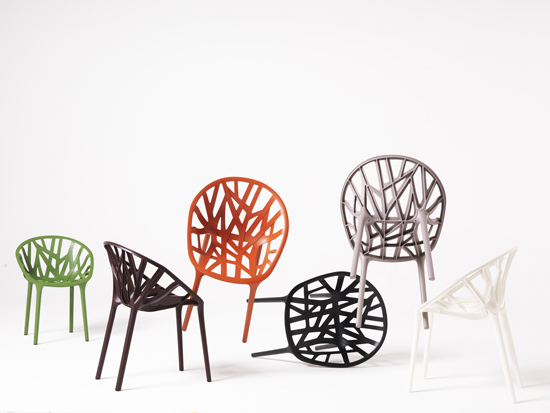
A development process lasting four years resulted in the Bouroullec Brothers' indoor and outdoor 'Vegetal' chair for Vitra, 2008; © Vitra
×How do you judge the success of a product that you've designed?
We've done a lot of disasters. But we've had the chance to do best-sellers, too. It's a mix, really. The spectrum of our work is quite large. It's through this that we do some pieces for galleries, which is perhaps a way to get a bit of oxygen. To consider things in a different light. We work a lot with craftsman. We recently did a carpet in Pakistan. We work in a lot of different fields, so the criteria for what is good and what is not is not always the same. For me, the fact that I don't regret something a few months later is a criterion. And there are a lot of projects that I still regret ten years later. When you work for industry, you just hope for you and for them that there will be some commercial success, but for me it's maybe not enough.
A robust, precisely shaped knit, stretched over a metal frame provides the structure for Erwan and Ronan Bouroullec's ergonomic 'Slow' chair for Vitra, 2006; © Vitra
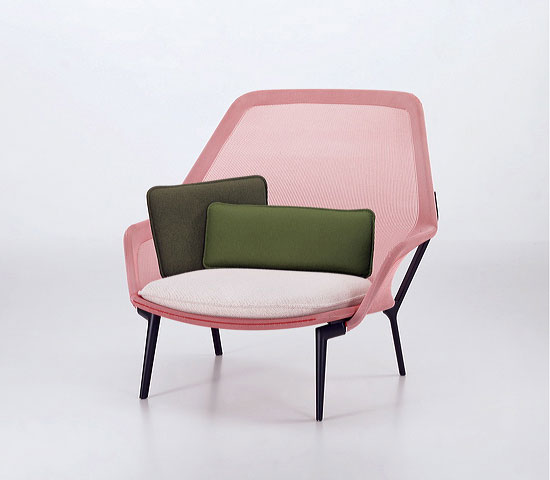
A robust, precisely shaped knit, stretched over a metal frame provides the structure for Erwan and Ronan Bouroullec's ergonomic 'Slow' chair for Vitra, 2006; © Vitra
×What about professional success? As we've just seen, people want to have their photograph taken with you. You both have a certain profile. What effect does that have on creativity? Do you feel under a certain amount of pressure?
Sure. I really felt more comfortable ten years ago. But, in the end, it's a way to push yourself, to be stronger. Before we worked quickly, now we take a long time to develop something, to make sure it is balanced. It's certainly linked to this pressure, but perhaps at the same time we create a more interesting type of project. You're seeing me here at the fair in a certain context, but the fact is that 99% of the time I'm with my brother, just fighting. This here is just five or ten days in the year. It's quite difficult to reach us when we are in Paris. There's a firewall around us made up of our assistants. We don't have a lot of meetings.
Design squatting: the Bouroullecs' products form a dialogue with Le Corbusier's Unité d'Habitation in Marseilles in a 2010 project called 'Apartment 50', where one of the iconic building's dwellings was given a temporary fit-out; © Studio Bouroullec
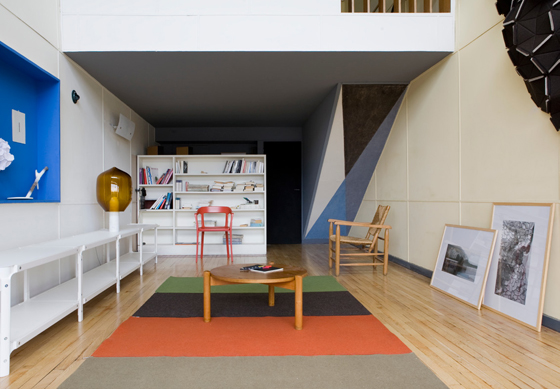
Design squatting: the Bouroullecs' products form a dialogue with Le Corbusier's Unité d'Habitation in Marseilles in a 2010 project called 'Apartment 50', where one of the iconic building's dwellings was given a temporary fit-out; © Studio Bouroullec
×I found two of your recent projects particularly fascinating. One was 'Apartment 50', the fit-out of the dwelling in the Unité d'Habitation – your products placed in a pre-existing architectural space. Do you think much about contextual space when you're designing objects? Do you think about how they might be placed and used?
It's true that I'd love to be an architect, but I'd be bad at it. I don't have a sense of space, really. When I design an object, I do consider this question, but I think what we are good at is turning something around. For space and understanding the articulation of it, we're bad.
The second project is the 'Album' show in Bordeaux, which is interesting in terms of challenging hierarchy. So here you have various project types...
There are 900 documents. Drawings, pictures... It's like portraiture.
Egalité: the Bouroullec Brothers' 'Album' exhibition at Bordeaux's arc en rêve comprises 900 drawings, pictures and other documents from their archive, all given equal importance through their presentation in the same format; © Studio Bouroullec
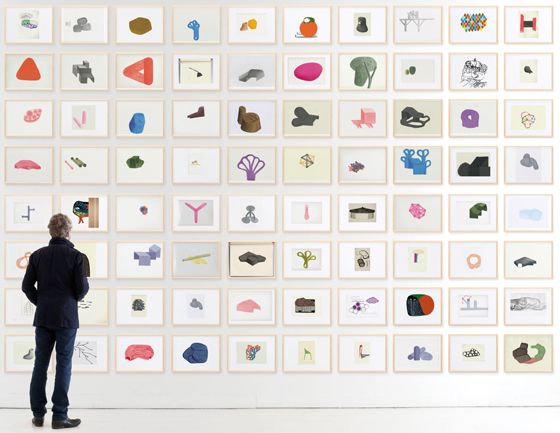
Egalité: the Bouroullec Brothers' 'Album' exhibition at Bordeaux's arc en rêve comprises 900 drawings, pictures and other documents from their archive, all given equal importance through their presentation in the same format; © Studio Bouroullec
×And all presented in the same format. I thought this might be saying something about our fixation with industrially produced design. Here, it's given no special important above ideas that were never developed that far. It's a level field. What was the motivation for you behind making this show?
Well, we ended up doing two shows in the same year, which is a bit complicated. We were almost obliged if we did one to do the other. So the other will be at the Centre Georges Pompidou in Metz, which will be the last 15 years of our work presented just in objects. While the first exhibition is a show without objects. Here, we wanted to show our concern with objects from all different points of view. The drawings and so on. All of that is very important for us, especially because the design process is a very frustrating one. It takes more than a couple of hours to turn something around. For example, one of the last collections we did, for Axor, was six years of work, dealing with robots and so on. So to have the chance to take care of pictures, to take care of text...
We work in a certain melancholic way, I think, or maybe a certain romantic way. We work in an old atelier. We do a lot of mock-ups, which is a totally outdated way to work, but we feel comfortable with that. We like this tactile way of doing things. This is just us.
Many thanks for your time, Ronan.
....
Die „Album“ Ausstellung ist im „Arc en Rêve Centre d'Architecture“ in Bordeaux vom 27.01.2011 bis zum 24.04. 2011 zu sehen.
A retrospective of the Bouroullecs' work will open at the Centre Pompidou-Metz in October 2011, running until the spring of 2012.
Currently running at the Centre Pompidou-Metz is the museum's inaugural show, 'Chefs-d'oeuvre?', which features an installation by the Bouroullec Brothers with Xavier Veilhan. It closes on 30 August, 2011.



